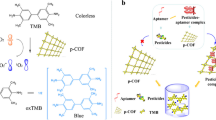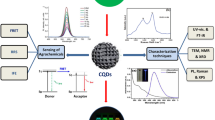Abstract
In this work, chemosensors based on mixed ligands were proposed for the cooperative detection of Co2+. The relationship between the specifically selected mixed organic ligands and the detection activities is discussed. Diverse responses to metal ions can be tuned by controlling the structural features of organic ligands, such as different sizes, geometries, substituents, and connectivity. Among the nine investigated systems, DHAB–Tpy, DHAB–Phen, and DHAB–Dpa displayed high selectivity and sensitivity for Co2+, with detection limits of 4.5 × 10−7 M, 1.1 × 10−7 M, and 8.0 × 10−8 M, respectively. The detection of Co2+ was not affected by other metal ions, anions, amino acids, proteins, nucleic acids, lipids and pH conditions. Furthermore, the proposed method was validated in the analysis of Co2+ in real water samples with satisfactory recovery and relative standard deviation values. TAC–Phen and TAC–Dpa could recognize Co2+ qualitatively, but could not detect Co2+ quantitatively. While TAC–Tpy, PAN–Tpy, PAN–Phen, and PAN–Dpa showed no metal ion selectivity. The experimental results were also rationalized by theoretical studies. A mixed ligand system can be used to produce a ratiometric absorption signal to avoid most ambiguities, such as the chemosensor environment and concentration, via self-calibration of two absorption bands. Structural insights derived from detection activities can provide valuable information for the design of new metal ion chemosensors by varying the type of organic ligands.

The work represents a simple strategy for obtaining synthesis-free, inexpensive, and sensitivity-tunable chemosensors through mixing organic ligands of different sizes, substitutions, geometries, and connectivity to modulate the sensing behaviors.








Similar content being viewed by others
References
Cheng J, Zhou X, Xiang H. Fluorescent metal ion chemosensors via cation exchange reactions of complexes, quantum dots, and metal–organic frameworks. Analyst. 2015;140:7082–115.
Li X, Gao X, Shi W, Ma H. Design strategies for water-soluble small molecular chromogenic and fluorogenic probes. Chem Rev. 2014;114:590–659.
Wang J, Liu HB, Tong Z, Ha CS. Fluorescent/luminescent detection of natural amino acids by organometallic systems. Coord Chem Rev. 2015;303:139–84.
Liu Z, He W, Guo Z. Metal coordination in photoluminescent sensing. Chem Soc Rev. 2013;42:1568–600.
Chhatwal M, Kumar A, Singh V, Gupta RD, Awasthi SK. Addressing of multiple-metal ions on a single platform. Coord Chem Rev. 2015;292:30–55.
Bencini A, Lippolis V. 1,10-Phenanthroline: a versatile building block for the construction of ligands for various purposes. Coord Chem Rev. 2010;254:2096–180.
Wang J, Ha CS. A colorimetric and fluorescent turn-on chemosensor for Zn2+ based on an azobenzene-containing compound. Tetrahedron. 2009;65:6959–64.
Chen Y, Jiang J. Porphyrin-based multi-signal chemosensors for Pb2+ and Cu2+. Org Biomol Chem. 2012;10:4782–7.
Lee HJ, Cho CW, Seo H, Singha S, Jun YW, Lee KH, et al. A two-photon fluorescent probe for lysosomal zinc ions. Chem Commun. 2016;52:124–7.
Anzenbacher P, Jursíková K, Sessler JL. Second generation calixpyrrole anion sensors. J Am Chem Soc. 2000;122:9350–1.
Ru J, Chen X, Guan L, Tang X, Wang C, Meng Y, et al. Ratiometric iridium (III) complex-based phosphorescent chemodosimeter for Hg2+ applicable in time-resolved luminescence assay and live cell imaging. Anal Chem. 2015;87:3255–62.
Bozdemir OA, Guliyev R, Buyukcakir O, Selcuk S, Kolemen S, Gulseren G, et al. Selective manipulation of ICT and PET processes in styryl-bodipy derivatives: applications in molecular logic and fluorescence sensing of metal ions. J Am Chem Soc. 2010;132:8029–36.
Du J, Huang Z, Yu XQ, Pu L. Highly selective fluorescent recognition of histidine by a crown ether–terpyridine–Zn (II) sensor. Chem Commun. 2013;49:5399–401.
Liu Z, Jia X, Bian P, Ma Z. A simple and novel system for colorimetric detection of cobalt ions. Analyst. 2014a;139:585–8.
Liu HB, Zhao HY, Tong Z, Zhang Y, Lan B, Wang J. A colorimetric, ratiometric, and fluorescent cobalt (II) chemosensor based on mixed organic ligands. Sensors Actuators B Chem. 2017;239:511–4.
Ding Y, Zhu WH, Xie Y. Development of ion chemosensors based on porphyrin analogues. Chem Rev. 2017;117:2203–56.
Fermi A, Bergamini G, Roy M, Gingras M, Ceroni P. Turn-on phosphorescence by metal coordination to a multivalent terpyridine ligand: a new paradigm for luminescent sensors. J Am Chem Soc. 2014;136:6395–400.
Alreja P, Kaur N. Recent advances in 1,10-phenanthroline ligands for chemosensing of cations and anions. RSC Adv. 2016;6:23169–217.
Xu Z, Baek KH, Kim HN, Cui J, Qian X, Spring DR, et al. Zn2+-triggered amide tautomerization produces a highly Zn2+-selective, cell-permeable, and ratiometric fluorescent sensor. J Am Chem Soc. 2010;132:601–10.
Liu Y, Fei Q, Shan H, Cui M, Liu Q, Feng G, et al. A novel fluorescent ‘off-on-off’ probe for relay recognition of Zn2+ and Cu2+ derived from N,N-bis(2-pyridylmethyl)amine. Analyst. 2014b;139:1868–75.
Sakamoto R, Iwashima T, Kögel JF, Kusaka S, Tsuchiya M, Kitagawa Y, et al. Dissymmetric bis (dipyrrinato) zinc (II) complexes: rich variety and bright red to near-infrared luminescence with a large pseudo-stokes shift. J Am Chem Soc. 2016;138:5666–77.
Shellaiah M, Simon T, Srinivasadesikan V, Lin CM, Sun KW, Ko FH, et al. Novel pyrene containing monomeric and dimeric supramolecular AIEE active nano-probes utilized in selective “off–on” trivalent metal and highly acidic pH sensing with live cell applications. J Mater Chem C. 2016;4:2056–71.
Shellaiah M, Rajan YC, Balu P, Murugan A. A pyrene based Schiff base probe for selective fluorescence turn-on detection of Hg2+ ions with live cell application. New J Chem. 2015;39:2523–31.
Funding
We gratefully acknowledge financial support from the NSFC (Grant Nos. 21567002, 31560014) and Hundred-Talent Program (Guangxi Province).
Author information
Authors and Affiliations
Corresponding authors
Ethics declarations
Conflict of interest
The authors declare that they have no conflict of interest.
Additional information
Publisher’s note
Springer Nature remains neutral with regard to jurisdictional claims in published maps and institutional affiliations.
Electronic supplementary material
ESM 1
(PDF 2.18 mb)
Rights and permissions
About this article
Cite this article
Wang, J., Liang, J., Liu, X. et al. Mixed organic ligand-based colorimetric and ratiometric chemosensors for Co2+: structure–activity relationships. Anal Bioanal Chem 411, 2663–2674 (2019). https://doi.org/10.1007/s00216-019-01707-3
Received:
Revised:
Accepted:
Published:
Issue Date:
DOI: https://doi.org/10.1007/s00216-019-01707-3




